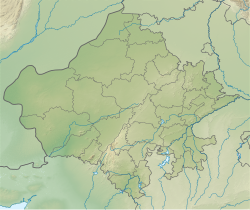| Jaisalmer Fort | |
|---|---|
Swarna Durg, Jaisalmer Quilla or Sonar Quila | |
| Jaisalmer, Rajasthan, India | |
 Jaisalmer Fort | |
| Coordinates | 26°54′46″N 70°54′45″E / 26.9127°N 70.9126°E |
| Type | Desert fortification |
| Site information | |
| Controlled by | Archaeological Survey of India |
| Open to the public | Yes |
| Condition | Protected Monument |
| Site history | |
| Built | 1155 AD |
| Built by | Rawal Jaisal |
| Garrison information | |
| Occupants | About a quarter of Jaisalmer's population |
| Type | Cultural |
| Criteria | ii, iii |
| Designated | 2013 (36th session) |
| Part of | Hill Forts of Rajasthan |
| Reference no. | 247 |
| Region | South Asia |
Jaisalmer Fort is situated in the city of Jaisalmer, in the Indian state of Rajasthan. It is one of the very few "living forts" in the world (such as Carcassonne, France), as nearly one fourth of the old city's population still resides within the fort.[1][2] For the better part of its 860-year history, the fort was the city of Jaisalmer. The first settlements outside the fort walls, to accommodate the growing population of Jaisalmer, are said to have come up in the 17th century.[1]
Jaisalmer Fort is the second oldest fort in Rajasthan, built in 1156 AD by the Rawal (ruler) Jaisal from whom it derives its name, and stood at the crossroads of important trade routes (including the ancient Silk road).[1]
The fort's massive yellow sandstone walls are a tawny lion colour during the day, fading to honey-gold as the sun sets, thereby camouflaging the fort in the yellow desert. For this reason it is also known as the Swarn Durg, Sonar Quila or Golden Fort.[3] The name Sonar Quila (Bengali for Golden Fortress) was popularized by tourists after famous Bengali film of the same name, that was shot in this fort by eminent filmmaker Satyajit Ray. The fort stands amidst the sandy expanse of the great Thar Desert on Trikuta Hill, hence also known as Trikutgarh. It is today located along the southern edge of the city that bears its name; its dominant hilltop location making the sprawling towers of its fortifications visible for many miles around.[4]
In 2013, at the 37th session of the World Heritage Committee held in Phnom Penh, Cambodia, Jaisalmer Fort, along with five other forts of Rajasthan, was declared a UNESCO World Heritage Site under the group Hill Forts of Rajasthan.[5]
- ^ a b c "Fort full of life". www.frontline.in. Retrieved 10 December 2017.
- ^ contributor, Shalbha Sarda (13 November 2023). "A UNESCO World Heritage site with thousands of people living inside it". CNBC. Retrieved 18 November 2023.
{{cite web}}:|last=has generic name (help) - ^ "The Fantastic 5 Forts: Rajasthan Is Home to Some Beautiful Forts, Here Are Some Must-See Heritage Structures". DNA : Daily News & Analysis. 28 January 2014. Archived from the original on 24 September 2015. Retrieved 5 July 2015.
- ^ Sharma, Abha (23 September 2012). "Desert's sinking fort". The Hindu. Retrieved 4 July 2015.
- ^ Centre, UNESCO World Heritage. "Hill Forts of Rajasthan". UNESCO World Heritage Centre. Retrieved 12 February 2024.

